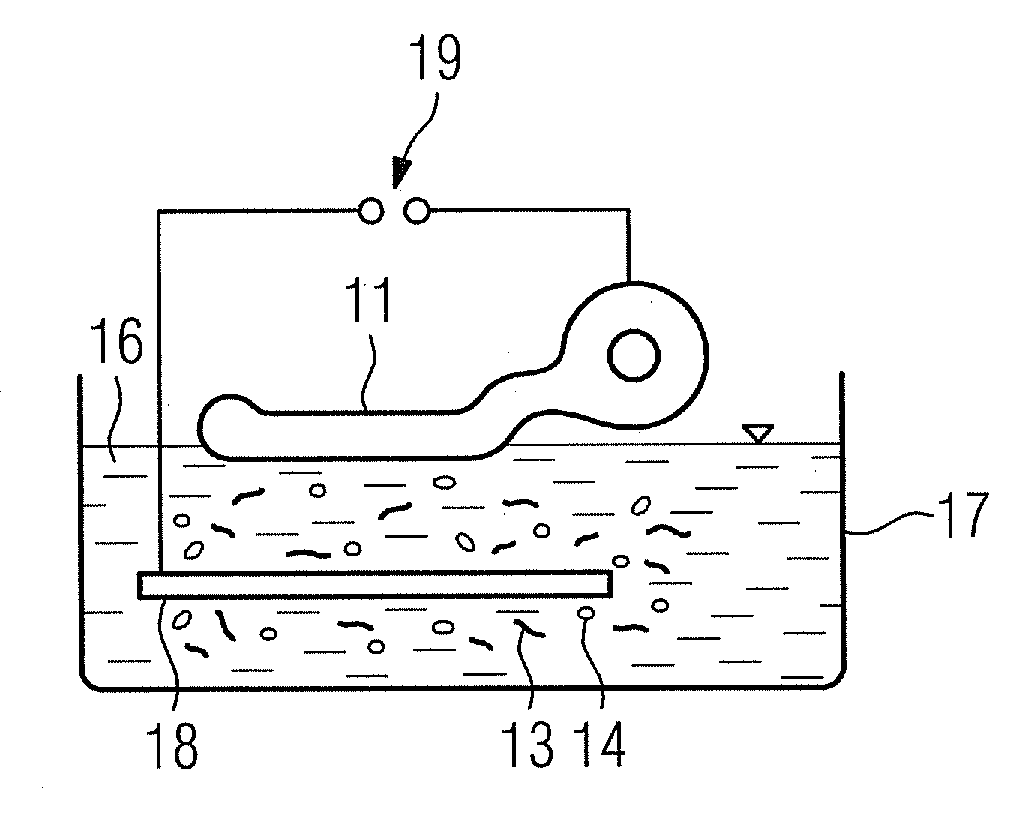[0005]This object is inventively achieved with the component mentioned at the start by a
dry lubricant being incorporated into the grains in addition to the CNT particles. The background of the inventive measure is that the incorporation of CNT, contrary to the widely-held belief among those skilled in the art, only inadequately improves the wear behavior of a
coating. CNT does actually improve the
hardness of the
coating, but the tribological behavior of surfaces is not solely influenced by their
hardness. Instead the lubricating properties of the coating during frictional stress are also of primary importance. This is the starting point of the invention, in that the particles of a
dry lubricant are also incorporated in addition to the CNT. Dry lubricants belong to a material group characterized by its ability to improve the lubricating properties of the surfaces involved. This advantageously reduces wear, which enables the component into the grains of which CNT and particles of a dry
lubricant are incorporated to achieve a better service life. In this case the grains of the layer form a matrix in which the particles of the dry
lubricant and the CNT, which can also be regarded as particles, are distributed dispersed. Because of their dimensions, the CNT represent nanoparticles. The particles of the dry
lubricant can be embodied as nanoparticles but can also have dimensions in the
micrometer range.
[0007]A further embodiment of the invention is obtained if the layer has metallic grains, especially made of a
nickel-
cobalt alloy. The metallic grains of the layer make it possible to conduct the
electrical current with advantageously low electrical resistance.
Nickel-
cobalt alloys in particular are suitable for
electrical switching elements since they combine comparatively good electrical and
thermal conductivity with a satisfactory wear behavior. Thus the optimization potential through the incorporation of CNT and dry lubricant particles can advantageously be used especially well.
[0008]In accordance with another embodiment of the invention there is provision for the layer to have a
ceramic grain or at least
ceramic grain proportions, especially made of oxidic or nitridic ceramics such as
titanium nitride. This advantageously enables very hard
layers, for coating a tool for example, to be produced, with their tribological behavior able to be optimized by embedding of the dry lubricant particles. This enables the service life to be advantageously improved. At the same time the
thermal conductivity of the CNT can be used in order for example to effectively dissipate the heat from
cutting tools. The reduction in thermal stress advantageously simultaneously leads, at high
cutting speeds of the tool, to an improved service life, or makes it possible to
cut at higher speeds with the same service life.
[0015]Another especially advantageous form of embodiment of the inventive method is obtained if an ionic fluid is used as an
electrolyte for the coating. Fluid salts in which the salt is not dissolved in a
solvent (preferably water) are referred to as ionic liquids. This involves
organic liquids which are composed of cations and anions. In the present case alkalized imidazolium,
pyridinium,
ammonium or
phosphonium ions are used as cations. Simple halogenides, tetrafluorborate, hexafluorphosphate, Bi(trifluoromethylsulfonyl)
imide or Tri(pentafluoroethyl)trifluorphosphate can typically be used as anions. The effect of choosing these cations and anions is that the ionic fluids are available in the fluid state at temperatures of below 100° C., preferably even at
room temperature. Because of their
chemical structure, ionic fluids possess surfactant-type properties, which is why these fluids are excellently well suited to the production of dispersions. The ionic fluid acts in such cases as a means of dispersion, with the dispersants to be dispersed able to be microparticles or nanoparticles and being formed in the invention by the CNT and the particles of the dry lubricant. Advantageously this enables
wetting agents for dispersal to be dispensed with, which avoids the properties of the particles incorporated into the electrochemically-fabricated layer being adversely affected by built-in
wetting agents. In addition comparatively high concentrations of dispersed particles can be achieved in ionic fluids, whereby higher incorporation rates into the layer to be created are also advantageously achieved.
[0016]In addition the metals can also be deposited from the ionic fluid as
nano crystalline metal layers. In this regard the parameters in accordance with WO 2006 / 061081 A2 or information provided by F. Endres, “Ionische Flüssigkeiten zur Metallabscheidung (Ionic fluids for
metal deposition)”, Nachrichten aus der Chemie, 55, May 2007, Pages 507 to 511, should be taken into account. The structure of
nano crystalline metal layers is advantageously especially well suited to the incorporation of CNT as well as the particles of the dry lubricant, so that advantageously especially high incorporation rates can be achieved.
 Login to View More
Login to View More 

